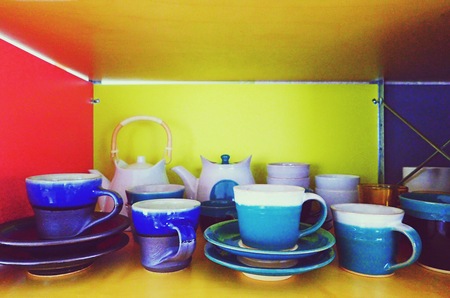民藝に繊細さを
民藝には繊細さが無い、とした。
その辺、柳宗理ディレクションは民藝に繊細な部分を持ち込もうとした痕跡があり、端々に厚みを消す処理を施しているように思える。
繊細さは美術品のようであり、民藝品は美術品の対極にあり、繊細さを求めることは美術品を目指すことであり、民藝にとってはタブーなのだろう。
厚みの厚さは民藝の象徴であり、そこに、丈夫で、毎日の生活の中での使用に何十年と耐える、そこにものとしての価値と美がある、ことを現している。
だから、民藝品の美と美術品の美は違う、という解釈が、民藝に携わる人には成り立つし、成り立たないと都合が悪いのだろう、使う我々にとっては関係ないところで。
美は美で、美の根本は同じで、民藝品とか、美術品とか、の違いは一部のつくり手と売り手が意識しているだけの話。
あとちょっと、ほんのちょっと繊細ならば完璧、端が、先が、あと1mm、いやあと、0.5mm薄ければ、細ければ、言うことないものばかり。
それを学んだのは、柳宗理の作品を見て、日常使いしているからなんだけどなと、場末の呑み屋でホッピー呑みながら想う。
"Delicacy in folk art"
It is said that folk art has no delicacy.
In that area, Yanagi Sorihi has traces of trying to bring delicate parts into folk arts, and seems to be applying treatment to eliminate the thickness.
Delicateness seems to be a work of art, folk art is on the opposite side of artworks, seeking delicacy is aiming at art objects, and for folk arts it is taboo.
The thickness of the thickness is a symbol of folk art, and it is strong, it shows that there are values and beauty there as it can withstand decades for use in everyday life.
Therefore, the interpretation that the beauty of a folk art and the beauty of a work article are different for a person engaged in folk arts, and it is not convenient if it does not make it, it is not related to us.
Beauty is beauty, the fundamentals of beauty are the same, the difference between folk art items and art goods is only the story of some making mind and seller conscious.
After a while, perfect if slightly delicate, end, tip, 1 mm afterward, no more, 0.5 mm thin, if it is thin, nothing to say.
I learned it because I see Mr. Yoshinori's works and I use it everyday, but I think while swallowing Hoppy at the sweet shop at the end.


コメント